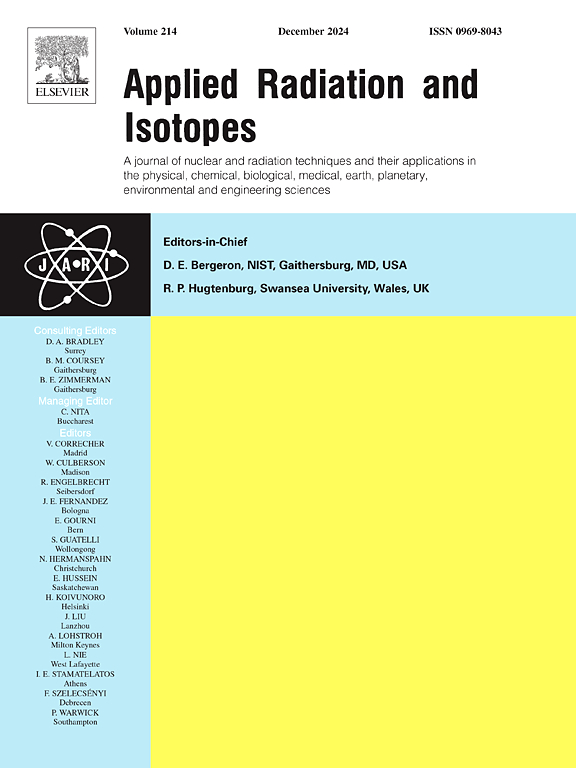Thermoluminescence characteristics of Zn2SiO4/SiO2:Mg nanophosphor under X-ray irradiation
IF 1.6
3区 工程技术
Q3 CHEMISTRY, INORGANIC & NUCLEAR
引用次数: 0
Abstract
In thermoluminescence (TL) dosimetry, the choice of materials and their preparation method are crucial in achieving an efficient dosimeter. Zinc silicate materials have attracted a lot of attention due to their promising luminescence efficiency. However, the luminescence properties of these materials when doped with magnesium have received less attention. In this research, the TL properties of the synthesized Zn2-xSiO4/SiO2:Mgx (ZSMg-x) nanophosphors have been studied for the first time. X-ray diffraction (XRD), scanning electron microscopy (SEM), and energy dispersive X-ray spectroscopy (EDS) analyses were performed to study the crystal structure and morphology of the nanophosphors. The photoluminescence (PL) emission spectrum shows emission bands peaking at wavelengths of 295, 428, 485, 521, and 736 nm. TL glow curves of the fabricated ZSMg-0.5 nanophosphors were analyzed using a computerized glow curve deconvolution program based on the general order Kinetics. Magnesium doping of the Zn2SiO4/SiO2 nanophosphor was found to increase luminescence intensity, resulting in high sensitivity to X-rays. This study showed the effectiveness of ZSMg-0.5 nanophosphor for dosimetry of X-ray radiation.
Zn2SiO4/SiO2:Mg纳米荧光粉在x射线照射下的热释光特性
在热释光剂量学中,材料的选择及其制备方法是实现高效剂量计的关键。硅酸锌材料因其具有良好的发光效率而受到广泛关注。然而,这些材料在掺杂镁后的发光特性却很少受到关注。本研究首次对合成的Zn2-xSiO4/SiO2:Mgx (ZSMg-x)纳米荧光粉的TL性质进行了研究。通过x射线衍射(XRD)、扫描电镜(SEM)和能谱分析(EDS)研究了纳米荧光粉的晶体结构和形貌。光致发光(PL)发射光谱在295、428、485、521和736 nm波长处达到峰值。利用基于一般顺序动力学的计算机辉光曲线反褶积程序分析了制备的ZSMg-0.5纳米荧光粉的TL辉光曲线。在纳米荧光粉中掺入镁元素可以提高发光强度,提高对x射线的灵敏度。本研究显示了ZSMg-0.5纳米磷光体在x射线辐射剂量学中的有效性。
本文章由计算机程序翻译,如有差异,请以英文原文为准。
求助全文
约1分钟内获得全文
求助全文
来源期刊

Applied Radiation and Isotopes
工程技术-核科学技术
CiteScore
3.00
自引率
12.50%
发文量
406
审稿时长
13.5 months
期刊介绍:
Applied Radiation and Isotopes provides a high quality medium for the publication of substantial, original and scientific and technological papers on the development and peaceful application of nuclear, radiation and radionuclide techniques in chemistry, physics, biochemistry, biology, medicine, security, engineering and in the earth, planetary and environmental sciences, all including dosimetry. Nuclear techniques are defined in the broadest sense and both experimental and theoretical papers are welcome. They include the development and use of α- and β-particles, X-rays and γ-rays, neutrons and other nuclear particles and radiations from all sources, including radionuclides, synchrotron sources, cyclotrons and reactors and from the natural environment.
The journal aims to publish papers with significance to an international audience, containing substantial novelty and scientific impact. The Editors reserve the rights to reject, with or without external review, papers that do not meet these criteria.
Papers dealing with radiation processing, i.e., where radiation is used to bring about a biological, chemical or physical change in a material, should be directed to our sister journal Radiation Physics and Chemistry.
 求助内容:
求助内容: 应助结果提醒方式:
应助结果提醒方式:


